
11 minute read
Naval Aviation and Maintenance Transformation: Improving Readiness for the 21st Century
from MECH Fall 2005
Improving Readiness for the 21st Century
By Dan Steber
Advertisement
NORFOLK, Va.— Mech recently interviewed the Commander, Naval Air Systems Command, VADM Wally Massenburg. He had a lot to say about the transformation in naval aviation and its impact on maintenance and readiness. VADM Massenburg discussed several programs and tools related to Naval Aviation Enterprise (NAE), including AIRSpeed, Boots on the Ground (BOG), the Naval Aviation Readiness Integrated Improvement Program (NAVRIIP), Lean, Basic Theory of Constraints (BTOC), and Six Sigma. These terms and programs may sound strange to some, but they have been around for several years, and already have allowed the fleet to reap the benefits in readiness.
BOG is an event that brings together the leadership of the NAE to walk through the AIMDs, MALS and the squadrons to hear their concerns and provide points of contact to resolve their readiness barriers.
“Shake a thousand Sailors’ hands,” said VADM Massenburg as he described his metric for success with BOG. “Senior leaders have to get out from behind a desk and go face the customers. Everything that ‘providing organizations’ do starts with Sailors and Marines and ends with Sailors and Marines. If you aren’t always
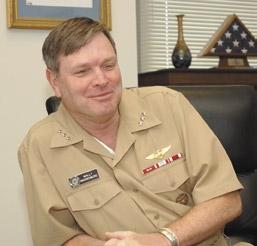

focused on them, you have missed the boat.” The NAE and associated programs essentially started in 1999, after the Navy’s early attempts to recapitalize the force fell short. “People with good hearts said the only way to get new equipment is to get rid of the older equipment quicker,” said VADM Massenburg. “But we mortgaged on the backs of our Sailors and Marines the attempt to recapitalize our force.”
The admiral mentioned that BOG allowed Sailors to vent about the lack of supply parts on the shelf, about old support equipment—much of it older than the planes we’re flying—and tech pubs that were falling apart, or NATOPS manuals that hadn’t been updated in three years.
He went on to explain that as budgets and buying power went down, the cost of aircraft and equipment went up. “We had to get the money from some place,” VADM Massenburg commented. “That scenario made it clear that the effort to recapitalize was going to be tough.”
His point, though, is that the initial strategy had to change. “Naval Aviation was a two-headed giant and each head had its own ideas,” said VADM Massenburg.
A catalyst in that effort was the a little stick and rudder, NAE was new CNO at the time, Admiral Vern born. Clark. Adm. Clark placed CNAP in In the early days, the work charge of all naval aviation, making to improve readiness through him the single process owner, the triad began to show promise. accountable for all of its problems. From those successes, the Naval
With CNAP, now called ComAviation Integrated Improvement mander Naval Air Forces (CNAF), Program (NAVRIIP) and Enterclearly in charge and accountable, prise AIRSpeed was born. It used a strategy began to develop. The the tenets of Lean Manufacturleadership of CNAL, NAVAIR ing, Basic Theory of Constraints and OPNAV saw the benefits of and Six Sigma, and is teaching breaking the traditional chain of maintainers a new language that command lines and as VADM Masincludes a variety of tools and senburg put it, “ I called VADM terms, such as value-stream mapMalone, CNAF, and reported for duty. You see, I work for ping, the 5 Ss, Kaizen events, Kanban, and a host of the fleet and CNAF represents what the fleet needs.” others. They are part of a new revolution in thinking
With this, a triad began to take shape. CNAF at that is a critical part of the Naval Aviation Enterprise the top directing requirements, NAVAIR at one corner and something every Sailor and Marine should learn. as a provider, and OPNAV N-78 and N-43 in the other VADM Massenburg urged Mech to speak to the corner with the resources—the cash. The fleet sits in fleet about this change in maintenance, supply and the center. readiness. He suggested we contact AIMD North Island,
“The NAE is working to define better metrics that since they had recently transformed their work process tie what we work on directly to readiness and aircraft using the above tenets. ready for tasking at reduced cost. NAVRIIP and AIRSpeed are leading the way. These metrics BEFORE will help the NAE manage its cost so we can afford our future aircraft without sacrificing readiness like we had to do in the past,” said VADM Massenburg.
This triad began working together toward a fleet goal of aircraft ready for training by attacking the shortfalls in material readiness with NAVRIIP and it’s enabler, AIRSpeed.
As the triad drilled down to the root of naval aviation’s material readiness issues, it became apparent more commands would need to be brought on board. The organization expanded into the Naval Aviation Enterprise. Composed of over 22 commands, the NAE is a forum where interdependent issues affecting Batching life preservers led to confusion and reduced quality assurance. Only one pressure and vacuum line created a bottleneck. Large toolboxes took up space and tools were inefficiently organized. multiple commands are resolved using the measurement of aircraft ready for tasking at reduced costs Excessive inventory in loft—out of site, out of as the goal for all decisions. With mind—wasted floor space below.

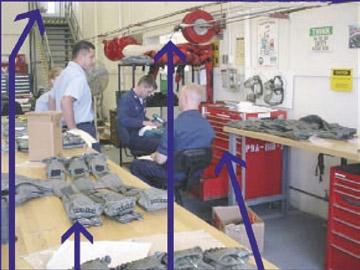
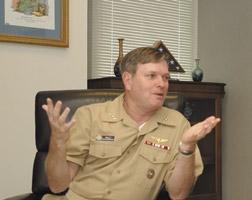
“Enterprise AIRSpeed has This transformation in naval avihad a huge impact on the way we ation maintenance is dynamic and do business,” said PR2(AW/SW) ensures that effective, efficient and Jason Moore. “It was a major shift more productive work is being done in the way we think and act. Before to improve current and future readiAIRSpeed, we might work on every ness. Petty Officer Moore said the part, regardless of priority. Now, we biggest difference is that maintainconcentrate on high-priority parts ers are being empowered to make and don’t work on pri 3 parts with change. little or no demand.” “AIRSpeed has changed the way
He explained that the time we think and work,” said Moore. saved through that approach and a “Earlier efforts didn’t have buyreorganization of work flow, tools, in from junior troops. Now E-1s and consumable parts has allowed through O-5s meet in team meetAIMD North Island to make draings where junior Sailors interact matic financial savings and to produce a greater number with senior members, get a voice in the final decision, of items of higher quality. and see their suggestions come to life. That is real
“In our T-700 engine shop, we reorganized the flow change.” of work, put the right tools into our maintainers’ hands, “We found last year that AVDLR consumptions increased and moved consumables closer to the worker, went way down,” said Massenburg, “because a Sailor on and made tremendous improvement,” Petty Officer the hangar deck is being empowered and is being held Moore said. “The turnaround time went from 72 to 48 accountable and responsible at his level for how much days, using the Basic Theory of Constraints and from 48 parts or equipment cost, not just for how to install them. to nine days, using Lean and Six Sigma.” We get away from ‘smoke checking’ R/Ts or using parts in supply to troubleshoot airAFTER craft and those kinds of things. Another benefit is that our Sailors and Marines now have a way to feel proud about what they’re doing, have the necessary tools and all elements of Integrated Logistics Support in place, and we have folks with the same patriotic feelings about their job and want to serve.” Bob Dylan said it best, “The Times They Are A-Changin’.” The Naval Aviation Enterprise is moving forward and will be coming to a squadron near you. It’s time the entire fleet prepares for the lean, clean, readinessimprovement machine. For more information on the Naval Aviation Enterprise, AIRSpeed, NAVRIIP, and the Decreased clutter and increased workspace by placing monitors Smaller toolboxes for each workstation improved efficiency. Pressure and vacuum lines are hard plumbed to additional workstations, so two techs can work on life “lean” tools mentioned, visit the Naval Aviation Enterprise webunder tables. preservers instead of one. site at www.nae.cnaf.navy.mil or NAVAIR site at Removed excessive inventory from hidden upstairs storage area www.navair.navy.mil/ and removed staircase to place reduced inventory in sight. navairairspeed.

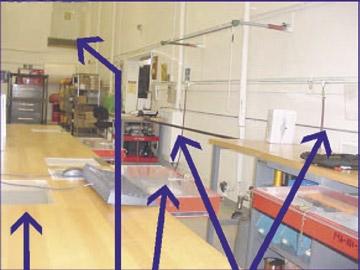

By the VFA-14 Safety Department


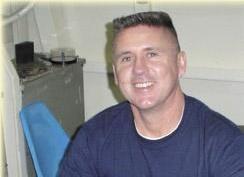
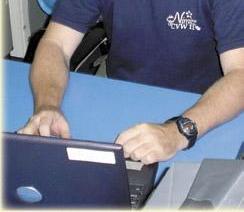



One of the biggest challenges facing any safety department is keeping people interested. We’ve all heard the safety officer who sounds like a broken record and have seen the outdated safety stand-down videos from the ‘70s. People seem to spend more time making fun of the “cheesy” mustaches than listening to the message.
AO1 (AW) Jeffrey Campbell, VFA-14 Safety Petty Officer, recognized the need for a new communication tool to deliver information about current operations shortly after joining the Tophatter Safety Department. He noticed as soon as copies of Approach and Mech were distributed throughout the squadron, people quickly would sit down to see what the new issue had to offer. Hoping to capitalize on the popularity of fresh reading material in the shops, Petty Officer Campbell began publishing a squadron safety newsletter titled The Safe Way.
The newsletter is published twice per month and it is focused on issues that are most relevant to the current operations of the squadron. The VFA-14 Safety Department uses the newsletter to publish information from daily airwing safety meetings when embarked, as well as lessons learned from recent hazard reports.
The Safe Way has proven to be a very effective way to highlight individuals who have contributed to keeping the squadron running smoothly. When a Sailor prevents an accident or uncovers a discrepancy that might have gone otherwise unnoticed, their actions are described in the newsletter as a reward and as evidence to others that we all are responsible for correcting any hazards we find. Reducing Mishaps—Saving Lives—Improving Readiness
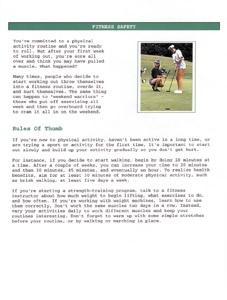



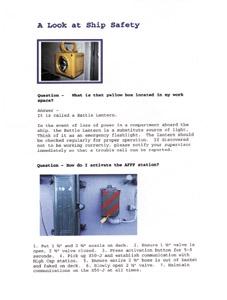
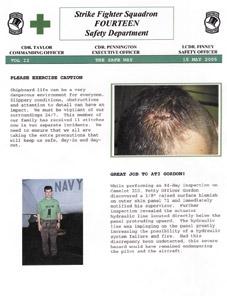




Critical Eye Award
Dear Editor,
The summer 2005 Mech magazine rear cover is a poor example of how to work safely. Yes, the service member is wearing gloves and eye protection and yes, a harness to prevent him from falling in the hole. The problem is that that lanyard needs to be connected to a 5,000-pound tie off point. Having another service member wrap it around his body and hand is totally unsat. If the welder falls in that hole, the shock load will pull the second service member in also, especially on the surface he’s on (asphalt with loose gravel on it). It will be just like he’s on marbles. Please say something in your next issue so service members won’t think this is an acceptable practice. Thanks.
Brion K. Hall
NAVOSH Specialist, CPSI
Naval Air Station Brunswick
Thanks for your input. We always welcome a reader’s critical eye and suggestions for improving safety in the fleet. Now we ask you to take the same critical eye to your work center and identify safety hazards that may have become routine. We all share responsibility for practicing risk management both on and off duty. Some additional guidance on fall protection can be found below and on the Naval Safety Center website. —Ed. Marine Corps Occupatonal Safety and Health Program http://safetycenter.navy.mil/instructions/osh/ MCOP51008F.pdf 19003.2.c – Personal Fall Arrest System. Composed of a body harness, lanyard with shock absorbing device, self-locking connectors, and horizontal, vertical, or selfretracting lifeline, and anchor point. All system components must be rated at 5,000 pounds breaking strength and compatible for use together as a system. Anchorages for lifelines must be independent of any anchorages used for suspended platforms, scaffolding, etc. Personal fall arrest system cannot allow worker free-fall distance to exceed six feet. NOTE: Marine Corps personnel will not use body belts due to potential to “fall through” the belt if turned upside down. Department of the Navy Fall-Protection Guide for Ashore Facilities http://safetycenter.navy.mil/osh/downloads/AshoreFall ProtectionGuide.pdf Body Restraint System: An application of the fall protection equipment, in which horizontal travel is restricted, preventing exposure to fall hazards. The system consists of a strap device, such as chest harness or full-body harness that can be secured around a worker and attached to a load-bearing anchorage in order to restrict travel and limit fall hazards. The strap can be single or multiple. (See figure below.)
Body Restraint System
11.0 Identification, Use, Selection, Certification, and Re-certification of anchorages Anchorages can either be engineered or improvised. An anchorage system is a combination of anchorage point and anchorage connector(s). Improvised fall-arrest anchorages and anchorage connectors shall withstand a force of 5,000 pounds for every person attached to the system. Positioning and restraint anchorage shall withstand a force of 3,000 pounds.










